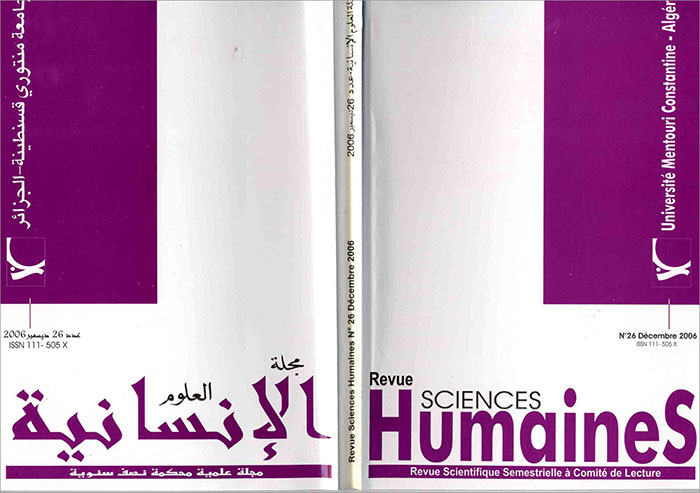Effects of formal instruction on second language acquisition
الملخص
This article attempts to put light on the potential effects of grammar instruction on Second / Foreign Language Acquisition. In the last decades, some well-known researchers have cast doubt on the utility of formal instruction for speaking and writing correctly. We will examine recent theoretical and empirical research literature in order to find out the dominant stand amongst researchers regarding the real effects of any focus on form on subsequent language acquisitionالتنزيلات
المراجع
Bialystok, Ellen. 1981. “The role of linguistic knowledge in second language use”. Studies in Second Language Acquisition, 4/1: 31-45.
-Bialystok, Ellen. 1982. “On the relationship between knowing and using linguistic forms”.Applied Linguistics, 3/3: 181-206.
-Cadierno, Teresa. 1995. “Formal instruction from a processing perspective: An investigation into the Spanish past tense”. The Modern Language Journal. 79/2: 179-193.
-Day, Elaine M. and Shapson, Stan M. 1991. “Integrating formal and functional approaches to language teaching in French immersion: An experimental study”. Language Learning, 41/1: 25-58.
-Dekeyser, Robert M. 1998. “Beyond focus on form: Cognitive perspectives on learning and practicing second language grammar”. In C. Doughty & J. Williams (eds.), Focuson Form in Classroom Second Language Acquisition, (pp. 42-63). Cambridge: CUP.
Dulay, H. & Burt, M. 1973. “Should we teach children syntax?” Language Learning, 23: 245-58.
Dulay, H. & Burt, M. 1974. “Natural sequences in child second language acquisition”. Language Learning, 24: 37-53.
Ellis, Rod. 1984a. “Can syntax be taught? A study of the effects of formal instruction on the acquisition of WH questions by children”. Applied Linguistics, 5/2: 138-155.
Ellis, Rod. 1984b. Classroom Second Language Development. London: Pergamon Press.
Ellis, Rod.1985. Understanding Second Language Acquisition. Oxford: OUP.
Ellis, Rod. 1990. Instructed SLA: Learning in the Classroom. Oxford: Blackwell.
Ellis, Rod. 1992. Second Language Acquisition and Second Language Pedagogy. Clevedon: Multilingual Matters Ltd.
Ellis, Rod. 1994. The Study of Second Language Acquisition. Oxford: OUP.
Ellis, Rod. 1997. SLA Research and Language Teaching. Oxford: OUP.
Fotos, Sandra S. 1994. “Integrating grammar instruction and communicative language use through grammar consciousness-raising tasks”. TESOL QUATERLY, 28/2: 323-51.
Green, Peters & Hecht, Karlheinz.1992. “Implicit and explicit grammar: An empirical study”. Applied Linguistics, 13/2: 168-184.
Harley, Birgit.1989. “Functional grammar in French immersion: A classroom experiment”.Applied Linguistics, 10/3: 331-359.
Johnson, Keith.1982. Communicative Syllabus Design and Methodology. Oxford: Pergamon Press.
Kadia, Kayiba.1988. “The effects of formal instruction on monitored and on spontaneous naturalistic interlanguage performance: A case study”. TESOL QUATERLY, 509-515.
Krashen, Stephen D. 1987. Principles and Practice in Second Language Acquisition. New York: Printice Hall International.
Krashen, Stephen D. 1992. “Under what circumstances, if any, should formal grammar instruction take place?”. TESOL QUATERLY, 26/2: 405-411.
Larsen-Freeman, Diane and Long, Michael H. 1991. An Introduction to Second Language Acquisition Research. London: Longman.
Lightbown, Patsy M. and Pienemann, Manfred. 1993. “Comments on Stephen D. Krashen’s ‘Teaching issues: Formal grammar instruction’”. TESOL QUATERLY, 27/4: 717-722.
Littlewood, William. 1981. Communicative Language Teaching. Cambridge: CUP
Long, Michael H. 1983. “Does second language instruction make a difference? A review of Research”. TESOL QUATERLY, 17/3: 359-382.
Long, Michael H. 1988. “Instructed interlanguage development”. In L. M. Beebe (eds.), Issues in Second Language Acquisition: Multiple Perspectives, (pp.115-141). New York: Newbury House.
Neman, Beth S. 1980. Teaching Students to Write. (Second edition 1995.) Oxford: OUP.
Newmark, Leonard.1970. “Grammatical theory and the teaching of English as a foreignlanguage”. In M. Lester (eds.), Readings in Applied Transformational Grammar, (pp. 210-218), New York: Holt Rinehart.
Pica, Teresa.1983. “Adult acquisition of English as a second language under different conditions of exposure”. Language Learning, 33: 465-497.
Pienemann, Manfred. 1984. “Psychological constraints on the teachability of languages”. Studies in Second Language Acquisition, 6: 186-214.
Pienemann, Manfred. 1989. “Is language teachable? Psycholinguistic experiments and Hypotheses”. Applied Linguistics, 10/1: 52-79.
Prabhu, N.S. 1987. Second Language Pedagogy. Oxford: OUP.
Seliger, Herbert W. 1979. “On the nature and function of language rules in language Teaching”. TESOL QUATERLY, 13/3: 359-369.
Sharwood-Smith M. 1981. “Consciousness-raising and the second language learner”.AppliedLinguistics2:159-168
.Spada, Nina. 1997. “Form-focused instruction and second language acquisition: A review of classroom and laboratory research”. Language Teaching, 30/2: 73-85.
Stevick, Earl W. 1980. A Way and Ways. Rowley, M.A.: Newbury House.
Tarone, Elaine. 1983. “On the variability of interlanguage systems”. Applied Linguistics, 4/2: 143-63.
Terrell, Tracy David. 1991. “The role of grammar instruction in a communicative approach”. The Modern Language Journal, 75/1: 52-63.
Terry, Shortall. 1999. “The grammar question”. The Language Teacher, 23/6: 31.
VanPatten, Bill. 1986. “Second language acquisition and the learning / teaching of Spanish: Some research findings and their implications”. Hispania, 69: 202-216.
VanPatten, Bill & Cadierno, Teresa.1993a. “Explicit instruction and input processing”. Studies in Second Language Acquisition, 15: 225-243.
White, Lydia. 1991. “Adverb placement in second language acquisition: Some effects of positive and negative evidence in the classroom”. Second Language Research, 7: 133- 161.
White, Lydia et al. 1991. “Input enhancement and L2 question formation”. Applied Linguistics, 12: 416-432.
Widdowson, H.G. 1978. Teaching Language as Communication. Oxford: OUP.
















